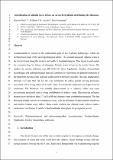Files in this item
Identification of Atlantic water inflow on the north Svalbard shelf during the Holocene
Item metadata
| dc.contributor.author | Peral, Marion | |
| dc.contributor.author | Austin, William | |
| dc.contributor.author | Noormets, Riko | |
| dc.date.accessioned | 2022-09-29T23:37:47Z | |
| dc.date.available | 2022-09-29T23:37:47Z | |
| dc.date.issued | 2021-09-30 | |
| dc.identifier | 276054037 | |
| dc.identifier | 224fb8eb-39cb-40da-b859-75bb541a6323 | |
| dc.identifier | 85116035923 | |
| dc.identifier | 000701536500001 | |
| dc.identifier.citation | Peral , M , Austin , W & Noormets , R 2021 , ' Identification of Atlantic water inflow on the north Svalbard shelf during the Holocene ' , Journal of Quaternary Science , vol. Early View . https://doi.org/10.1002/jqs.3374 | en |
| dc.identifier.issn | 0267-8179 | |
| dc.identifier.uri | https://hdl.handle.net/10023/26104 | |
| dc.description | MP thanks the ERASMUS + programme for the financial support during her secondment at the University of St Andrews. | en |
| dc.description.abstract | Nordaustlandet is located in the northeastern part of the Svalbard archipelago, within the northernmost reach of the West Spitsbergen Current. This current transports Atlantic water to the Arctic Ocean along the western and northern Svalbard margins. This region is well-suited for reconstructing the history of changing Atlantic water inflow to the Arctic Ocean. We studied the marine sediment core HH12-04-GC from Rijpfjorden. Benthic foraminiferal assemblages and sedimentological data are combined to reconstruct the paleoenvironment of the fjord from the end of the last local deglaciation to the late Holocene. The local deglaciation, between 11.3 and 10.6 cal. ka BP, was dominated by active glacier calving processes, associated with a strong inflow of Atlantic water. This led to the establishment of glaciomarine conditions. The Holocene was initially characterized by a relatively stable and warm environment associated with a strong contribution of Atlantic water. Glaciomarine influence progressively decreases after 9.7 cal. ka BP and Atlantic water contribution increases. The late Holocene display similar environment to today, with the influence of glaciomarine conditions and limited Atlantic water inflow. These results confirm that Atlantic water inflows made a continuous contribution to northern Nordaustlandet throughout the postglacial period. | |
| dc.format.extent | 3972948 | |
| dc.language.iso | eng | |
| dc.relation.ispartof | Journal of Quaternary Science | en |
| dc.subject | Paleoenvironment and paleoceanographic reconstructions | en |
| dc.subject | Nordaustlandet | en |
| dc.subject | Rijpfjorden | en |
| dc.subject | Benthic foraminifera | en |
| dc.subject | Sediments | en |
| dc.subject | GC Oceanography | en |
| dc.subject | GB Physical geography | en |
| dc.subject | DAS | en |
| dc.subject | SDG 14 - Life Below Water | en |
| dc.subject.lcc | GC | en |
| dc.subject.lcc | GB | en |
| dc.title | Identification of Atlantic water inflow on the north Svalbard shelf during the Holocene | en |
| dc.type | Journal article | en |
| dc.contributor.institution | University of St Andrews. Environmental Change Research Group | en |
| dc.contributor.institution | University of St Andrews. Coastal Resources Management Group | en |
| dc.contributor.institution | University of St Andrews. School of Geography & Sustainable Development | en |
| dc.contributor.institution | University of St Andrews. Marine Alliance for Science & Technology Scotland | en |
| dc.contributor.institution | University of St Andrews. Scottish Oceans Institute | en |
| dc.contributor.institution | University of St Andrews. St Andrews Sustainability Institute | en |
| dc.identifier.doi | 10.1002/jqs.3374 | |
| dc.description.status | Peer reviewed | en |
| dc.date.embargoedUntil | 2022-09-30 |
This item appears in the following Collection(s)
Items in the St Andrews Research Repository are protected by copyright, with all rights reserved, unless otherwise indicated.

